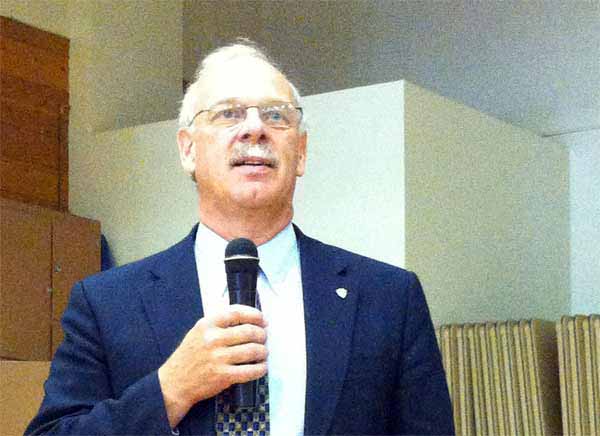
By Ruffin Prevost
CODY, WYO. — Though summer is just around the corner, Yellowstone National Park Superintendent Dan Wenk presented two vastly different possible scenarios for managing Sylvan Pass during a briefing Monday for local business owners.
Wenk and Grand Teton National Park Superintendent Mary Gibson Scott spoke to Cody Country Chamber of Commerce members as part of the town’s National Parks Day, a six-decade tradition where park managers share insights on the coming summer tourist season with business leaders in the gateway community.
One alternative outlined in a draft winter use management plan to be released next month would see Sylvan Pass operating as it was during the 2011-12 winter season, Wenk said.
Another alternative would see a “total closure” of the pass, including no use of a howitzer cannon to blast snow from the hillside. Under that alternative, the pass would be opened when snow is cleared mechanically and melts naturally from the mountain, Wenk said.
The 1.5 mile stretch of road at an elevation 8,524-feet lies between the East Gate and Fishing Bridge, and is subject to ongoing risk of avalanches throughout the winter. A 2007 winter-use plan proposed closing the pass, but public outcry from Cody residents and pressure from Wyoming elected officials brought about a working group and discussions with park officials that later resulted in a reversal of that decision.
Various conservation groups have objected to the risk, cost and potential environmental effects of using a cannon to mitigate avalanche risks along the pass.
Wenk said no determination has been made about whether either of the two scenarios he discussed would be chosen by the National Park Service as part of the preferred alternative for winter use management. But he said he hoped Cody residents would consider the proposal with open minds when it is released.
“I believe in this winter use plan — if you will look at it with recognition and open eyes — that we can make the park quieter, cleaner and we can allow for an increase in visitation to Yellowstone National Park,” he said.
Another alternative, though not necessarily a preferred one, to be included in the draft plan will allow one daily non-commercially-guided trip with up to five snowmobiles departing from each entrance, Wenk said.
That alternative was included as a result of comments from Cody residents and others made during the scoping process for winter use planning earlier this year, he said.
Wenk made an apparent acknowledgement of the contentious debate over Sylvan Pass in the past several years when he said he understood that it may not have always been a pleasure for Park Service personnel to visit Cody.
But he said that hasn’t been the case since he became superintendent.
“I think we’re really working on developing a good relationship between the park and Cody, and I appreciate all the efforts that you have made to be great leaders of Yellowstone National Park,” he said.
A shrinking Park Service budget, including a $35 million annual base budget for Yellowstone that is down about 5 percent from 2010, means that a call from some Cody residents to expand the summer season are virtually certain to go unfulfilled.
“Not only are we not expanding seasons, but we have to be very concerned about how we maintain the level of services that we provide in the park,” Wenk said.
“We’re past the point in the National Park Service where we can take it out of programs that don’t affect visitor services,” he said.
“The National Park Service is going through the same thing that every other federal agency is going through, with a high level of s and a desire to cut federal budgets,” he said.
Public access
Steve Torrey, a Cody resident who attended Monday’s luncheon, said the Park Service should do a better job of managing costs, and the agency should open roads as soon as possible.
He said Yellowstone employees enjoy administrative use of park roads in winter, summer and during shoulder seasons — including for personal recreation — while allowing taxpayers into the park less as public use seasons shrink.
Wenk said the Park Service had made “baby steps” over the winter in moving forward on bison management, working with the state of Montana to increase tolerance of the wandering wildlife in the gateway communities of West Yellowstone and Gardiner.
Working to curtail predatory lake trout in Yellowstone Lake will be a priority again this year, with the Park Service and Yellowstone Park Foundation each spending $1 million to keep four boat crews working to remove invasive lake trout, which feed on cutthroat trout. The native cutthroat are an important food source that affects more than 40 different species in the park, Wenk said.
Scott also addressed the Cody luncheon gathering, saying that Grand Teton was ready to welcome what she hopes will be a strong stream of summer visitors. She speaks Tuesday to Grand Teton area residents, making more extensive remarks as part of an annual address in Moose, Wyo.
Contact Ruffin Prevost at 307-213-9818 or [email protected].

The park belongs to everyone and there’s a select few who are blocking our chance to do business to support the “Programs” they want to keep.
The Buffalo don’t seem to have a problem with the cars zooming by in the Summer, so what’s the problem with the snowmobiles in the winter?
I had a guest ask me today about an Alpine Slide. I informed them about the proposed Zip Line and how it might impact the bears. She said, “Well, that’s up in the air, what’s the big deal?” Exactly. I’m guessing if there might not be a Zip line, then there would never be an alpine slide.
I had to send my guest to Jackson Hole.